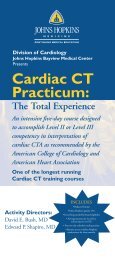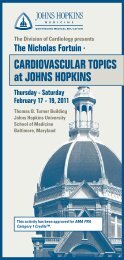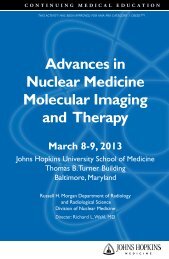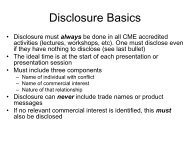View Transcript - Hopkins CME Blog
View Transcript - Hopkins CME Blog
View Transcript - Hopkins CME Blog
You also want an ePaper? Increase the reach of your titles
YUMPU automatically turns print PDFs into web optimized ePapers that Google loves.
eNEoNATAL REviEw poDcAST TRANScRipT<br />
MR. BoB BUSKER: Welcome to this eNeonatal<br />
Review Podcast.<br />
eNeonatal Review is presented by the Johns <strong>Hopkins</strong><br />
University School of Medicine, and the Institute for<br />
Johns <strong>Hopkins</strong> Nursing. This program is supported by<br />
educational grants from Abbott Nutrition, Cornerstone<br />
Pharmaceuticals, Ikaria, and Mead Johnson Nutrition.<br />
Today’s program is a companion piece to our<br />
eNeonatal Review newsletter issue: Optimizing<br />
Nutritional Support with Protein and Energy for<br />
Very Low Birth Weight Infants.<br />
Our guest today is one of that issue’s authors, Dr.<br />
David Adamkin, from the University of Louisville.<br />
This activity has been developed for neonatologists,<br />
respiratory therapists, nurse practitioners, neonatal<br />
nurses, and others who work in the NICU. There are<br />
no fees or prerequisites for this activity.<br />
The Accreditation and Credit Designation Statements<br />
can be found at the end of this podcast. For additional<br />
information about accreditation, <strong>Hopkins</strong> policies, and<br />
expiration dates and to take the posttest to receive<br />
credit online, please go to our website newsletter<br />
archive, www.eneonatalreview.org, and click the<br />
Volume 9, Issue 14 podcast link.<br />
Learning objectives for this audio program are, that<br />
after completing this activity, the participant will<br />
demonstrate the ability to:<br />
n Describe the importance of starting parenteral<br />
nutrition in the first hours of life, even in the face<br />
of critical illness in VLBW infants;<br />
n Evaluate the role of parenteral amino acids in<br />
glycemic control, as well as lipids in relation to lung<br />
dysfunction, in VLBW infants; and,<br />
n Discuss the role of donor-fortified milk in VLBW<br />
infants.<br />
I’m Bob Busker, managing editor of eNeonatal<br />
Review. On the line we have with us Dr. David H.<br />
Adamkin, Professor of Pediatrics, Director of the<br />
Division of Neonatal Medicine, and Rounsavall<br />
Endowed Chair of Neonatology, at the University<br />
of Louisville.<br />
Dr. Adamkin has indicated that he has no financial<br />
interests or relationships with any commercial entity<br />
whose products or services are relevant to the content<br />
of this presentation, and his discussion today will not<br />
reference the unlabeled or unapproved uses of any<br />
drugs or products.<br />
Dr. Adamkin, welcome to this eNeonatal Review<br />
podcast.<br />
DR. DAviD ADAMKiN: Thank you very much, Bob.<br />
MR. BUSKER: In your newsletter issue, Doctor, you<br />
reviewed studies describing the importance of<br />
enhancing nutrition in very low birth weight infants —<br />
that would be babies weighing less than 1500gm— to<br />
decrease morbidities and promote improved<br />
neurodevelopmental outcomes. What I’d like to do<br />
today is expand on that information, and discuss how<br />
it can actually be applied in the NICU. So if you<br />
would, doctor — start us out with patient scenario.<br />
DR. ADAMKiN: The case that we’re discussing is<br />
a 610 gm, small for gestational age, 26-week infant,<br />
delivered by emergency C-section because of placental<br />
abruption and fetal distress. Baby’s Apgar scores were<br />
2, 4, 6, and 8, at 1, 5, 10, and 15 minutes, respectively.<br />
Infant received positive pressure ventilation in the<br />
delivery room and was intubated and given surfactant.<br />
The cord blood pH is 7 with a base excess of -10. The<br />
infant is started on intravenous fluids of D10W<br />
through a UVC and D5W in the UAC for total fluids of<br />
80 cc/kg/daycc/kg/day.<br />
So this is a tiny baby that’s growth-restricted with a<br />
difficult initial course, including fetal acidosis, and is<br />
started on D10 and D5 through the UVC and the UAC.<br />
At 12 hours of age the morning labs include a plasma<br />
glucose of 180mg/dLmg/dL after two ACCU-CHEKs<br />
revealed 140 and 160, and the potassium is 7.3<br />
mEq/L. The infant’s urine output has been 1.5<br />
cc/kg/hr, the BUN is 15, and the creatinine is 0.7.<br />
MR. BUSKER: Why wasn’t this baby started on<br />
early TPN?<br />
DR. ADAMKiN: It’s possible, because of the baby’s<br />
condition at birth, the fetal hypoxia acidosis, that the<br />
clinicians were concerned about the baby’s ability to<br />
metabolize TPN and that may have been why the<br />
clinicians chose not to start TPN. Let’s delve into<br />
eNeonatal Review Podcast <strong>Transcript</strong>, Volume 9: Issue 14<br />
1
















